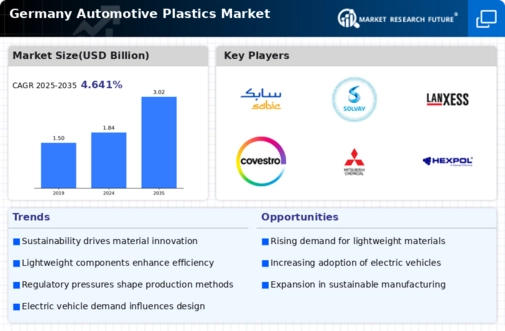The automotive plastics market in Germany is characterized by a dynamic competitive landscape, driven by innovation, sustainability, and technological advancements. Key players such as BASF SE (Germany), Covestro AG (Germany), and Evonik Industries AG (Germany) are at the forefront, each adopting distinct strategies to enhance their market positioning. BASF SE focuses on developing high-performance materials that cater to the evolving demands of the automotive sector, particularly in lightweighting and energy efficiency. Covestro AG emphasizes sustainability through its circular economy initiatives, aiming to produce plastics from renewable sources. Meanwhile, Evonik Industries AG is leveraging its expertise in specialty chemicals to create innovative solutions that enhance vehicle performance and safety, thereby shaping a competitive environment that prioritizes advanced materials and eco-friendly practices.
In terms of business tactics, companies are increasingly localizing manufacturing to reduce lead times and enhance supply chain resilience. The market structure appears moderately fragmented, with several players vying for market share while also collaborating on joint ventures and partnerships. This collective influence of key players fosters a competitive atmosphere where innovation and operational efficiency are paramount.
In November 2025, BASF SE (Germany) announced a strategic partnership with a leading automotive manufacturer to develop bio-based plastics aimed at reducing carbon emissions in vehicle production. This collaboration underscores BASF's commitment to sustainability and positions it as a leader in eco-friendly automotive materials. The strategic importance of this partnership lies in its potential to set new industry standards for sustainable practices in automotive manufacturing.
In October 2025, Covestro AG (Germany) launched a new line of high-performance polycarbonate materials designed specifically for electric vehicles. This initiative not only enhances the safety and durability of EV components but also aligns with the growing trend towards electrification in the automotive sector. The launch signifies Covestro's proactive approach to meeting the demands of a rapidly changing market landscape.
In September 2025, Evonik Industries AG (Germany) expanded its production capacity for specialty polymers used in automotive applications. This expansion is indicative of Evonik's strategy to capitalize on the increasing demand for lightweight materials that improve fuel efficiency. By enhancing its production capabilities, Evonik positions itself to better serve its customers and respond to market needs effectively.
As of December 2025, current competitive trends in the automotive plastics market are heavily influenced by digitalization, sustainability, and the integration of AI technologies. Strategic alliances are becoming increasingly vital, as companies seek to pool resources and expertise to drive innovation. The competitive differentiation is likely to evolve from traditional price-based competition towards a focus on technological advancements, sustainability, and supply chain reliability. This shift suggests that companies that prioritize innovation and sustainable practices will be better positioned to thrive in the future.



















Leave a Comment